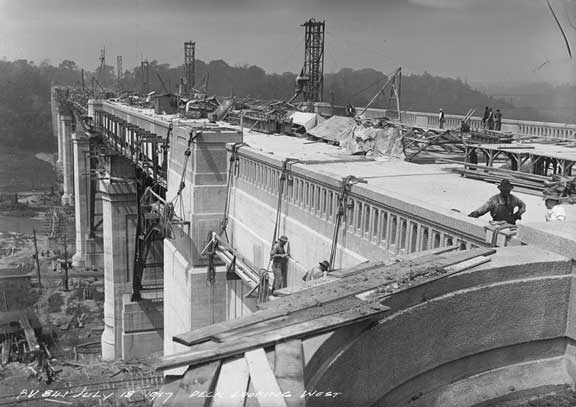
Construction of Toronto's Bloor Street Viaduct in 1917. Public Domain image from the Toronto Archives
Toronto’s Prince Edward Viaduct (most commonly known as the ‘Bloor Street Viaduct’) is one of my favorite pieces of infrastructure in all of my hometown.
This 1918 Art Deco masterpiece was the cornerstone of the city’s plans to connect the growing metropolis with disconnected suburbs across the Don Valley River system.
Is it functional? Yes. Is it beautiful? Absolutely. Most importantly, it’s one of the best examples of transit planning foresight I can think of.
At the time of first conception, R.C. Harris was the Commissioner of Public Works in Toronto. He was the brains behind the Viaduct and was a strong-headed and willful man. When conceiving and designing the Viaduct, he insisted upon incorporating a lower second deck to the bridge. This lower deck could allow for rail transport in the future, should it be required.
This was controversial because of the costs it added to the bridge and in the early 1910’s, there was no need for a rail or subway connection to the outlying suburbs. Toronto’s first subway line, after all, wouldn’t open until 1954, 46 years after the Viaduct opened to the public.
What R.C. Harris was doing, however, was not building a subway connection. Instead, he was leaving an essential tool in place for future generations to exploit should they decide to.
And decide they did.
When Toronto decided to build a second subway line in the 1960’s, the line was routed along the Bloor Street Viaduct’s lower second deck. This saved engineers and designers uncounted millions of dollars and time because no structural changes to the bridge needed to be made.
Today, cities across North America are building expensive transit lines that many argue are not economically sustainable given current ridership levels. Yonah Freemark makes this case compellingly clear, with a recent column at Next American City. The question is, are investments like these too often justified by the need to “plan for the future”?
And more importantly, is saddling future generations with money-losing transit infrastructure and the public debt used to pay for it truly looking out for these future generations? Should we not, maybe, plan more like R.C. Harris?
R.C. Harris’ lower deck was a minor expense that enabled future generations to realize their dreams, not his.
He didn’t say “we need a subway now!” Instead, R.C. Harris recognized that some day, some time in the future, some people may need a subway. And by including his lower deck, 56 years prior, he helped them to do it. R.C. Harris was a visionary because he was able to build the future through small investments in his own time.
He, quite literally, helped build Toronto from beyond the grave because he prioritized the future over the present and eschewed premature investments.
Our cities need more people like R.C. Harris.

2 Comments